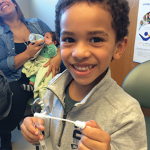ATLANTA—Around 2002, when Vincent Del Gaizo’s son was just 15 months old, he was hospitalized in an intensive care unit and, weeks later, was diagnosed with systemic juvenile idiopathic arthritis (JIA).
“We had the same 8 trillion questions that all parents have when their child is diagnosed with a condition you’ve never heard of: ‘Is he going to get better? What do these medications do? How are we going to treat this? What is his prognosis?’ All of the answers to our questions were, ‘We’re not sure. I don’t know.’” said Mr. Del Gaizo, who was then the owner of a dry cleaning business in New Jersey. “I felt we were just starting on a long journey to get to where we needed to be, to have knowledge to help us make the right decisions.”
Mr. Del Gaizo’s son was diagnosed with JIA by Yukiko Kimura, MD, a pediatric rheumatologist at Hackensack University Medical Center in New Jersey, who told him that “as researchers and clinicians, we have the same questions you do. We don’t know the answers, and the best ways to find them is to do it collaboratively.” She told him about a new organization, the Childhood Arthritis and Rheumatology Research Alliance (CARRA), which was formed to facilitate investigator-led pediatric rheumatology research studies to gather evidence and create a patient registry that would guide treatment decisions for pediatric patients.
The organization now includes families and patients in research as full partners, said Mr. Del Gaizo, who eventually left his business to work full-time for CARRA as director of strategic partnerships and patient engagement. He and Esi M. Morgan, MD, MSCE, a pediatric rheumatologist and researcher at Cincinnati Children’s Hospital, shared some of the barriers clinicians must overcome when recruiting families of children with juvenile rheumatic diseases into research studies at a session on Nov. 12 at the 2019 ACR/ARP Annual Meeting.
Full, Not Token, Research Partners

Mr. Del Gaizo
Pediatric rheumatologists need more involvement from patients and their families to increase the relevance and feasibility of their research studies, Mr. Del Gaizo said. Many barriers to enrolling pediatric patients in clinical trials—or any medical research—exist: According to a 2018 survey of 136 providers of pediatric healthcare conducted by the American Academy of Pediatrics, these barriers include lack of awareness, trial risks, and time and travel distance to participate in trials. The survey also found that parental concerns were greater obstacles to participation than ethical or regulatory barriers.1
Mr. Del Gaizo noticed many of these barriers as he became involved in pediatric rheumatology research more than 15 years ago. Through such organizations as CARRA, the Patient-Centered Outcomes Research Institute (PCORI), the Pediatric Rheumatology Care and Outcomes Improvement Network (PR-COIN) and the Partners Patient-Powered Research Network (PPRN), more parents and children are being recruited to partner in research studies, including the Start Time Optimization of Biologic Therapy in Polyarticular JIA (STOP-JIA) trial, which has enrolled 401 patients at 53 sites in the U.S. and Canada, he said. The trial examines when to start JIA patients on biologic therapy.2 Parents and patients are part of the study team, selected the trial’s patient-reported outcomes measures and created the recruitment tools.
In Limit-JIA, a current PCORI-funded trial of abatacept in children with JIA limited to four joints or fewer to determine if the drug can prevent uveitis and/or disease extension to more than four joints, three parents are part of the study team. They helped develop and conduct focus groups with other families to assess the relevance of the study’s aims and outcomes, and assisted researchers with protocol development.
How can researchers engage more families in pediatric rheumatology studies? Mr. Del Gaizo suggested these steps:
- Make an effort to get to know families of children with rheumatic diseases to “understand where they’re coming from and to empower and educate them” to partner with investigators as they develop shared study goals. Parents and pediatric patients should be viewed as full partners in studies, not as subjects of research;
- Explain terms or acronyms that may seem like the “alphabet soup of doctor-speak” to parents. STOP-JIA included plain-language health literacy policy developed by PARTNERS, a pediatric rheumatology patient research network, so “everyone was speaking the same language,” and created a newsletter formatted by a teenage patient that provided updates on the study and explained medical terminology; and
- Include parents and pediatric patients in the development of study survey or focus group questions and recruitment tools; they should be involved in conference calls and meetings related to the study, so they don’t become siloed and marginalized. Patients and their parents have much to contribute to meaningful research.
Patient Engagement: Investigator’s Perspective
When investigators include parents and pediatric patients on the research team from the inception of the study, “it increases the relevance of the results for implementation into clinical care,” said Dr. Morgan, who is the clinical lead/principal investigator for PR-COIN. Parents are on committees that review grant applications and help investigators determine which outcomes are of most interest to patients, she said.
Little research has been conducted on why patient engagement benefits research outcomes, but a 2014 systematic review of 142 studies found that although patient engagement in studies is feasible and increases the relevance of findings, a danger of patients being no more than tokens in the process exists, and involvement in research can be costly for parents and patients when it comes to time commitment, travel and absence from school or work.3 Mistrust of academia, scientists or medical research by patients or their parents are potential barriers to engagement. The study also found the most common time for patient involvement is at the beginning, when they are consulted to help set the agenda and develop protocols.
Patient engagement is required for grants to be funded by PCORI and other groups, and strong ethical reasons exist for involving them, said Dr. Morgan.
“If patients are going to be studied in research, they should have a say in the conduct of the study as well,” she said. “When you include patients on your research team, they are able to provide input on the study materials and recruitment tools, to attract more patients to participate. If you have more enrollment and patients stay involved longer, it will improve the relevance of your study. It will be a higher impact study. If you want people to adopt your findings into clinical care, you better start with outcomes that really make a difference for people.”
Dr. Morgan suggested three study phases with good opportunities for patient and parent engagement:
- Preparation, when they can help set agendas and goals;
- Execution, when they can consult on the study’s design and procedures and help with recruitment; and
- Translation, when they help investigators evaluate, disseminate and implement findings.
What are the best methods for engaging patients and parents in research? Although no studies have measured the effectiveness of different outreach techniques, best practices include reciprocal, transparent relationships among patients, parents and investigators. “Start out trying to build a relationship rather than saying, ‘We need a patient on our grant to be able to apply to PCORI.’ No, [the goal is] to improve the study and have a better impact,” Dr. Morgan said. “Make sure the patients and parents [who] are engaged are full members of the study team.”
Patients and parents can help deliver and disseminate study findings as well. “When patients are delivering your results, it’s very impactful,” she said.
Patients and parents engaged in study development should be compensated for their time—payments distinct from those made to human study subjects, which are governed by institute review boards, Dr. Morgan said.4
PCORI offers a free online resource to help researchers engage patients. Called Family and Youth Research Education: Trainings and Resources for Research Partnerships Involving Adolescents (FYREworks), it includes web-based training for researchers and patients, as well as recruitment toolkits.
Susan Bernstein is a freelance journalist based in Atlanta.
References
- Smith B, Benjamin D, Bradley J, et al. Investigator barriers to pediatric clinical trial enrollment: Findings and recommendations from the clinical trials transformation initiative. Pediatrics. 2018 May 1;142(1 Meeting Abstract):796.
- Ringold S, Tomlinson G, Weiss P, et al. The Childhood Arthritis and Rheumatology Research Alliance start time optimization of biologic therapy in polyarticular JIA study: Patient characteristics, patient reported outcomes and consensus treatment plan choices. Arthritis Rheumatol. 2019;71(suppl 10). [abstract 2703]
- Domecq JP, Prutsky G, Elraiyah T, et al. Patient engagement in research: A systematic review. BMC Health Serv Res. 2014 Feb 26;14:89.
- Patient-Centered Outcomes Research Institute. Policy statement: Financial compensation of patients, caregivers, and patient/caregiver organizations engaged in PCORI-funded research as engaged research partners. 2015 Jun 10.


